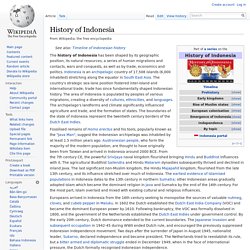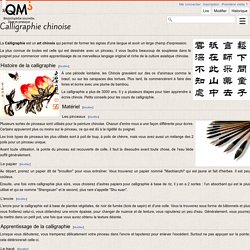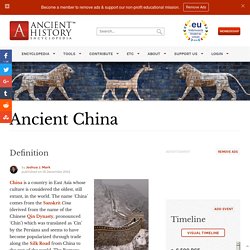

Korean War. The Korean War (25 June 1950 – 27 July 1953)[29][a][31] was a war between the Republic of Korea (South Korea), supported by the United Nations, and the Democratic People's Republic of Korea (North Korea), at one time supported by China and the Soviet Union.

Liste des héros, dieux et déesses ... pour A et B. Voyagez dans le temps sur les bords de Seine. China's Maps - ancient Chinese History.
Historian: The Koran Is NOT More Violent Than The Bible. Christians Have 'Holy Amnesia' Image Via YouTube Since the Paris attacks, all we’ve heard from the chattering class on the far right is that Islam is a religion of violence which mandates jihad, or holy war.

They even say the Koran is rife with incidents of violence and calls to kill all enemies of Islam. Which, if you didn’t know, is utter horse manure. But most of these self-appointed “experts” are reading the Koran selectively and cherry-picking certain verses which support their ludicrous assertions. History of Indonesia. The history of Indonesia has been shaped by its geographic position, its natural resources, a series of human migrations and contacts, wars and conquests, as well as by trade, economics and politics.

Indonesia is an archipelagic country of 17,508 islands (6,000 inhabited) stretching along the equator in South East Asia. The country's strategic sea-lane position fostered inter-island and international trade; trade has since fundamentally shaped Indonesian history. Kim Jong-un poised to extend his family's dynasty. The East Asian World Assessing Background Knowledge. David Guttenfelder Photography. Seeing Life For Yourself Here’s an interview for National Geographic about my work, and the power of photography, posted on the photoblog PROOF.

National Geographic turned the cameras around on 44 of its contributing photographers this year to ask about each’s persons life and journey. Produced by NatGeo senior picture editor Pamela Chen, and University of North Carolina’s Chad A. Stevens. Edited by Mika Chance. Feudalism in China. Feudalism in China[edit] Although Feudalism is often referred to as a European concept occurring in the medieval period, similar systems have been found to exist in many non-European parts of the world.

The Chinese history for instance, from the Zhou or Chou dynasty to the Qin Dynasty (1122 BC—256 BC)[1] has been termed a true feudal period by many Chinese marxist historians, due to the custom of enfeoffment of land similar to that in Europe. Calligraphie chinoise. La Calligraphie est un art chinois qui permet de former les signes d'une langue et avoir un large champ d'expression.

La plus connue de toutes est celle qui est dessinée avec un pinceau, il vous faudra beaucoup de souplesse dans le poignet pour commencer votre apprentissage de ce merveilleux langage original et riche de la culture asiatique chinoise. À une période lointaine, les Chinois gravaient sur des os d'animaux comme le bœuf, ou sur les carapaces des tortues.
Chine : histoire. Dès le iiie s. avant notre ère (-221), la Chine connaît la formation d’un État centralisé, œuvre de la dynastie des Qin issue de la lutte entre Royaumes combattants, et dont héritent les Han.

Toutefois, les invasions « barbares » en provenance du nord et du nord-est et/ou les rébellions intérieures affaiblissent à plusieurs reprises le pouvoir central, entraînant une division du pays entre le Nord et le Sud, du ive s. au vie s. Chine : histoire. Liu bang han dynasty. Ancient China. China is a country in East Asia whose culture is considered the oldest, still extant, in the world.

The name `China’ comes from the Sanskrit Cina (derived from the name of the Chinese Qin Dynasty, pronounced `Chin’) which was translated as `Cin’ by the Persians and seems to have become popularized through trade along the Silk Road from China to the rest of the world. The Romans and the Greeks knew the country as `Seres’, “the land where silk comes from”. The name `China’ does not appear in print in the west until 1516 CE in Barbosa’s journals narrating his travels in the east (though the Europeans had long known of China through trade via the Silk Road). Marco Polo, the famous explorer who familiarized China to Europe in the 13th century CE, referred to the land as `Cathay’. In Mandarin Chinese, the country is known as `Zhongguo” meaning `central state’ or `middle empire’. The Art of Asia. Tomb mystery: is this the grave of an Emperor?
Imperial China. History of Eritrea. Eritrea is an ancient name, associated in the past with its Greek form Erythraia, Ἐρυθραία, and its derived Latin form Erythræa.

This name relates to that of the Red Sea, then called the Erythræan Sea, from the Greek for "red", ἐρυθρός, erythros. The Italians created the colony of Eritrea in the 19th century around Asmara, and named it with its current name. After World War II Eritrea was annexed to Ethiopia. In 1991 the Eritrean People's Liberation Front defeated the Ethiopian government. Eritrea officially celebrated its 1st anniversary of independence on May 24, 1992.
Prehistory[edit] History of Somalia. Somalia (Somali: Soomaaliya; Arabic: الصومال aṣ-Ṣūmāl), officially the Federal Republic of Somalia (Somali: Jamhuuriyadda Federaalka Soomaaliya, Arabic: جمهورية الصومال الفدرالية Jumhūriyyat aṣ-Ṣūmāl al-Fideraaliya) and formerly known as the Somali Democratic Republic, is a country located in the Horn of Africa.

In antiquity, Somalia was an important centre for commerce with the rest of the ancient world,[1][2] and according to most scholars,[3][4] it is among the most probable locations of the fabled ancient Land of Punt.[5][6] During the Middle Ages, several powerful Somali empires dominated the regional trade, including the Ajuran Sultanate, Adal Sultanate, Warsangali Sultanate and Geledi Sultanate. Prehistory[edit] Somalia has been inhabited since the Palaeolithic period. Ancient[edit] Land of Punt[edit] Ancient maritime history[edit] The Indian merchants for centuries brought large quantities of cinnamon from Sri Lanka and Indonesia to Somalia and Arabia. The first warships. Kurdish people. The Kurdish people, or Kurds (Kurdish: کورد, Kurd), are an ethnic group in Western Asia, mostly inhabiting a region known as Kurdistan, which includes adjacent parts of Iran, Iraq, Syria, and Turkey.
They are an Iranian people and speak the Kurdish languages, which are members of the Iranian branch of Indo-European languages.[26] The Kurds number about 30 million, the majority living in West Asia, with significant Kurdish diaspora communities in the cities of western Turkey, in Armenia, Georgia, Israel, Azerbaijan, Russia, Lebanon and, in recent decades, some European countries and the United States. Etymology. Bambara Empire. The Bamana Empire (also Bambara Empire or Ségou Empire) was a large West African state based at Ségou, now in Mali. It was ruled by the Kulubali or Coulibaly dynasty established circa 1640 by Kaladian Coulibaly also known as Fa Sine or Biton-si-u. The empire existed as a centralized state from 1712 to the 1861 invasion of Toucouleur conqueror El Hadj Umar Tall.
Portal:Ancient Near East. Ancient Nubia: Home. Ray Hagins: Deconstructing the biblical psychosis 1. Columbia University. Google Albanie. Google Macedoine ? Chapter 15, Societies and Empires of Africa flashcards. Kingdom of Laos. The Kingdom of Laos was a constitutional monarchy that ruled Laos beginning with its independence on November 9, 1953. The monarchy survived until December 1975, when its last king, Savang Vatthana, surrendered the throne to the Pathet Lao, who abolished the monarchy in favor of a Marxist state called the Lao People's Democratic Republic, which has controlled Laos since.[1] Given self-rule with the new Constitution in 1947 as part of a federation with the rest of French Indochina,[2] the 1953 Franco-Lao Treaty finally established a sovereign, independent Laos, but did not stipulate who would rule the country.
In the years that followed, three groups led by the so-called Three Princes, contended for power: the neutralists under Prince Souvanna Phouma, the right-wing party under Prince Boun Oum of Champassak, and the left-wing, Vietnamese-backed Lao Patriotic Front (now called the Pathet Lao) under Prince Souphanouvong and future Prime Minister Kaysone Phomvihane. History[edit] Coordinates: Cairo to recognise South Sudan - Africa. Cairo will recognise South Sudan as an independent state, Nabil Elaraby, the Egyptian foreign minister, has said during a visit to Khartoum.
12 avril 1591 - Fin de l'empire songhai - Herodote.net. Le 12 avril 1591, une grande bataille a lieu sur les bords du Niger, à Tondibi. Burkina Faso. Burkina Faso ( i/bərˌkiːnə ˈfɑːsoʊ/ bər-KEE-nə FAH-soh; French: [buʁkina faso]), also known by its short-form name Burkina, is a landlocked country in West Africa around 274,200 square kilometres (105,900 sq mi) in size.
It is surrounded by six countries: Mali to the north; Niger to the east; Benin to the southeast; Togo and Ghana to the south; and Ivory Coast to the southwest. Its capital is Ouagadougou. Hiding in plain sight: Massive monument discovered at Petra by modern day Indiana Jones. Benin. Benin (/bɨˈnɪn/; French: Bénin, formerly Dahomey), officially the Republic of Benin (French: République du Bénin), is a country in West Africa. It is bordered by Togo to the west, by Nigeria to the east and by Burkina Faso and Niger to the north. A majority of the population live on its small southern coastline on the Bight of Benin, part of the Gulf of Guinea in the northernmost tropical portion of the Atlantic Ocean.[3] The capital of Benin is Porto-Novo, but the seat of government is in Cotonou, the country's largest city and economic capital. Benin covers an area of approximately 115,000 square kilometers (42,000 sq mi), with a population of approximately 9.98 million.
Benin is a tropical, sub-Saharan nation, highly dependent on agriculture, with substantial employment and income arising from subsistence farming.[4] Sculpture and Memorials - Entry - eMelbourne - The Encyclopedia of Melbourne Online. Melbourne's earliest outdoor artworks served both decorative and utilitarian functions. Ornamental drinking fountains were positioned on street corners, and reproduction classical busts were placed along the pathways of Melbourne's substantial parks and gardens. Woork Up - Web Design, Social Media, Tech News and Digital Inspiration. Politics of Burma. Burma (also known as Myanmar) is a unitary presidential constitutional republic under its 2008 constitution. Political conditions[edit] Historically, Burma was a monarchy ruled by various dynasties prior to the 19th century.
Half Lotus website. Eshnunna. Coordinates: 33°29′3″N 44°43′42″E / 33.48417°N 44.72833°E / 33.48417; 44.72833 Eshnunna (modern Tell Asmar in Diyala Province, Iraq) was an ancient Sumerian (and later Akkadian) city and city-state in central Mesopotamia. South African flag. Africa.
French colonial empire 1534-1980. Digital Public Library of America. Tha Illiad of MC Homer « ΜΙΚΡΟΚΟΣΜΟΣ. Moaïs on Easter Island. China says to step up vigilance after U.S. navy shift. Sun Jun 3, 2012 9:16am IST. UN notes ′dramatic increase′ in migrants arriving in Mediterranean. Kingdom of Hungary (1526–1867) Kingdom of Hungary (1526–1867) Bilad al-Sham 636 - 661. Italy. French colonial empire 1534-1980. The Hidden One (Canadian, American Indian, Native American Folktales)
The Surreal Reasons Girls Are Disappearing In El Salvador: #15Girls : Goats and Soda. Mirgration: Push and Pull Factors (AP Human Geography Documentary) List of island countries. Let's Travel. History of Bulgaria (1878–1946) Belgium. History of Belgium. Germany. Geography of Croatia. Montenegro. Greece. Bulgaria. Bulgaria. Geography of Slovenia.
Geography of Finland. History of Germany (1945–90. San Marino. Latvia. Bosnia and Herzegovina. Luxembourg. Albania. Slovenia. Serbia. Netherlands. Iceland. France. Diasporas - Circulations, migrations, histoire. Dark ages of Cambodia. Grands sites archéologiques. Hun_clothing. Ostia - Introduction. Vikings Invade England. Indus valley - Ancient India - society - Caste System - Daily Life. Quechua Language and the Quechua (Inca) Indians (Quichua, Inga, Runasimi) Greek Mythology. Ancient Greece - The British Museum. Famous Historic Buildings & Archaeological Sitesin China – Great Wall, Forbidden City, Temple of Heaven, Terracotta Warriors/Army, Potala Palace, Lhas. Outline of China.